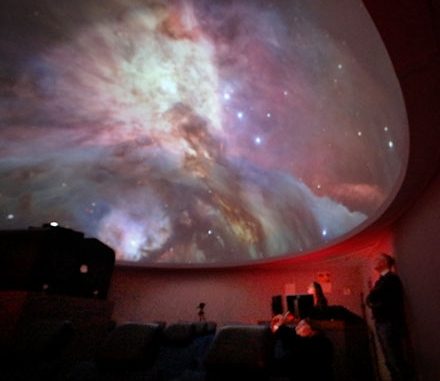
Kyora Wallace, Staff Writer |
This past Earth Day, on Apr. 22, the SUNY Oneonta Planetarium held a live show in the basement of the Perna Science building. The Planetarium felt like a home movie theater. You walk in and the seats are angled so you’re looking up. There are projections of space on the ceiling of the room, making the whole show extremely immersive.
Hosted by SUNY Oneonta Astronomer, Dr. Josh Nollenberg, the show started at 7 p.m. The show began with a talk on space news. Nollenberg mentioned that on Apr. 4, there was a wet dress rehearsal planned for a new rocket. A wet dress rehearsal is a test of whether or not a rocket is ready to launch safely. During this rehearsal, they stimulate all the stages of a rocket launch but never really launch the rocket. It’s used to test the equipment and procedures to ensure a safe launch into orbit. This test was planned for NASA’s newest moon rocket but was delayed due to a hydrogen leak. We then watched a video of a SpaceX launch where the rocket exploded.
Dr. Nollenburg then dimmed the light and started the show. We began talking about Eclipses and he showed how the moon passes through the Earth’s shadow in real-time. After a small conversation about the phenomenon, we transitioned into talking about Mars. Using visuals that were created by students, we moved through space to look at what it’s like on Mars. The surface of Mars is covered in Iron Oxide Particles, causing the planet to have a red hue. Hence, the nickname “The Red Planet.”
After getting a 360-degree view of the planet, we also saw the Curiosity Rover. The car-sized rover first landed on Mars in 2012, its goal was to find out if Mars is a habitable planet. Since its landing, the rover has found evidence of microbes on the planet. This means that it’s possible that Mars is in fact a habitable planet, but it’s not the only one we looked at.
After our tour of Mars, Dr. Nollenburg took us through space again to check out Saturn. First, we analyzed the surface. We took a close look at the rings of Saturn. The rings are thin and made up of ice and small moon particles. There are many moons in the rings of Saturn, the biggest of all being Titan.
After looking at Saturn, we began talking about black holes. Although it’s highly unlikely for a black hole to occur in our lifetime, it is interesting to think about. Using more student work, Dr. Nollenburg showed us what would happen if a black hole were to open next to Mars. The hole would make everything look distorted from our view.
Dr. Nollenburg says “If people don’t have appreciation for science, they don’t know how it benefits them in any way.” Science can often be an intimidating or confusing thing for those who don’t know much about it. However, you don’t need to fear what you don’t understand. Just simply appreciating the work is all you need to do.
On May 15, there will be a Lunar Eclipse. The Planetarium will host a telescope viewing between Perna Science and the Physical Science building. The Blood Moon will be hard to view on your own so make sure you go check it out. See you there!
Leave a Reply